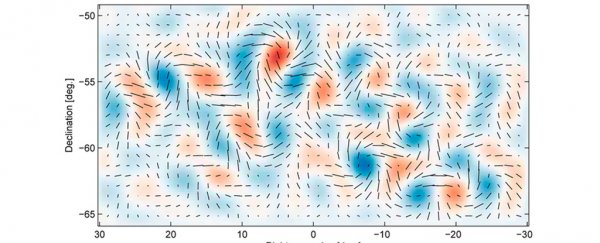If our Universe happened to be locked in an eternal heartbeat of expansion and collapse, black holes would leave an impression. And it could look just like a number of swirls recently detected in the faint echo of light at the edge of space.
It's hardly the smoking gun for what's called the conformal cyclic cosmology (CCC) model, especially given other things that could also explain these 'scars'. But it's definitely worthy of serious consideration.
Mathematical physicist Roger Penrose has a reputation on par with the likes of Stephen Hawking and Leonard Susskind. His model of a pulsating Universe with no beginning or end isn't everybody's cup of tea, but it is a contender for explaining the fate of everything.
As it stands, most cosmologists agree we live in an expanding Universe that started as a homogeneous point called a singularity, and we don't know what happened before it, or what could lie in our future.
Penrose's CCC model was developed as an answer to a curious imbalance between measurements of our early Universe's temperature and the state of order we might expect.
According to him, this imbalance could be accounted for by the death of a pre-existing universe that was there before the Big Bang. Oscillating universes come in a few different forms, depending on your choice of model. Some suggest the Universe is destined to fall back in itself one day.
Penrose's idea suggests the future isn't destined for a collapse – we'll keep expanding until everything evaporates into light and the very concept of space and time is made moot by the insane distances that exist.
At that point, our Universe is indistinguishable from a singularity, out of which another one might emerge.
It'd make for a great science fiction novel, but good science needs more than clever ideas. So Penrose has been on the hunt for observations that could support the CCC.
He might have found them in the form of swirling patterns of polarisations called B-modes in a map of ancient light called the Cosmic Microwave Background (CMB).
 B-mode polarisation patterns (BICEP-2)
B-mode polarisation patterns (BICEP-2)
These swirls of magnetic polarisation are believed to be produced by periods of inflation in the early Universe tugging on light, as well as other kinds of lensing effects. That's if they exist at all, and aren't just artefacts.
There's still a lot to learn about these swirls, especially since they were only detected a few years ago. For one thing, while gravitational waves might account for their characteristics, their fundamental cause is still up for debate.
In their recent report Penrose and his colleagues suggest these patterns might have an incredibly exotic origin.
They refer to 20 such B-modes on a CMB map that was created from data collected by a sensor called BICEP-2 back in 2014, and show how it's possible to trace their starting point back to evaporating black holes in a long-gone era.
Supermassive black holes at the core of galaxies are thought to slowly leak away over the aeons through the effects of Hawking Radiation. It's slow, but when you've got the lifetime of an expanding universe, why rush?
From one perspective, this excruciatingly long, slow death is hardly an explosion.
But if we ignore the whole time issue, that gradual blast becomes what Penrose calls a Hawking point, which might leave a subtle stain on the otherwise bland expanse from which another universe would generate.
Previously, Penrose had speculated that the space-quaking boom of colliding black holes in an earlier universe could be evidence of their existence.
Black holes are certainly responsible for some extreme phenomena, so if anything were to persist through the regeneration of a universe, it would be their death.
We shouldn't be quick to call this solid evidence quite yet. The study is available on the pre-peer review website arxiv.org, where it's drawing attention among the physics community.
BICEP-2 is also yet to release its raw data, which could change the numbers behind this aspect of the model. There's still a chance they're not real, but are aberrations caused by cosmic dust.
Penrose's team did use information from another set of CMB measurements taken with the Planck space telescope, running hundreds of simulations that all showed those B-modes popping up.
If B-modes are actual phenomena, and are the result of Hawking points, it would imply a whole new way of thinking about the infinite expanse of our Universe.
Space and time could be stretched so far they stop being meaningful in an old sense, only to be 'reset' for a fresh start.
What a poetic vision for the Universe.
